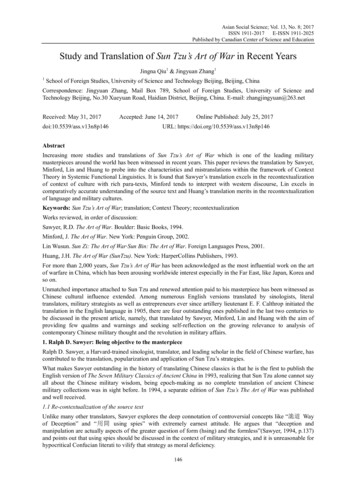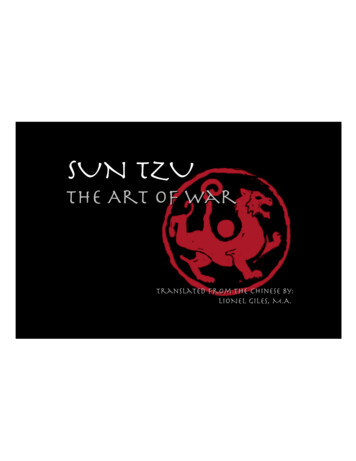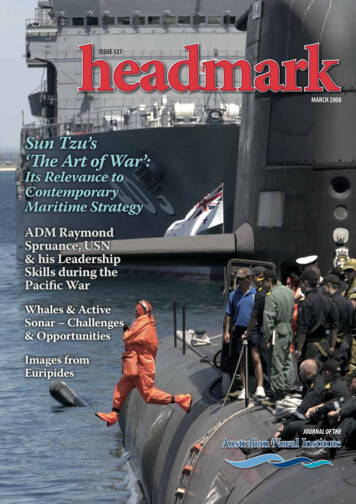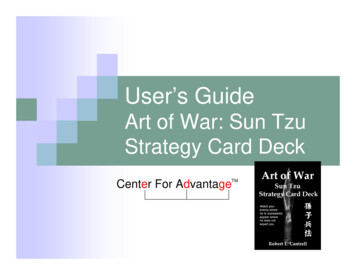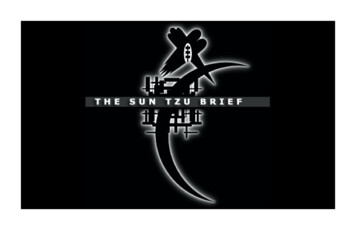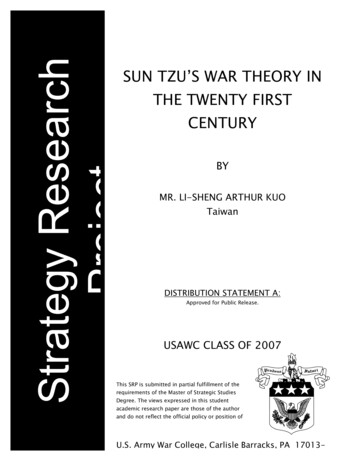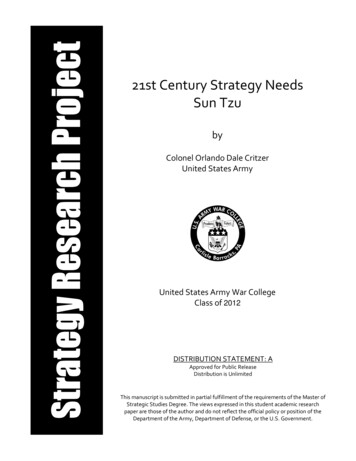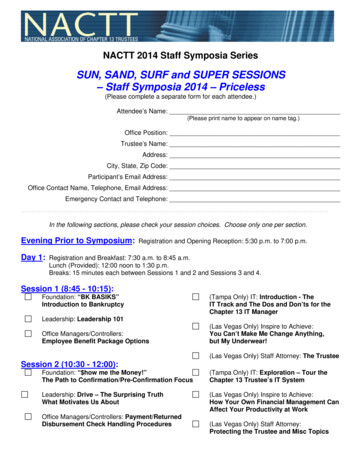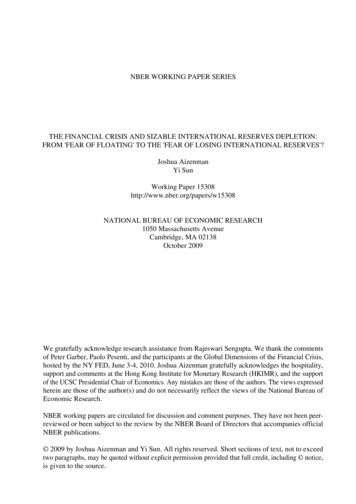
Transcription
Sun Tzuand the Art ofCyberwarRoy WilsonSun Tzu is widely recognized as the premier military strategist in the historyof the world. His book “The Art of War” was written approximately 2,500years ago in China but its strategic and tactical information remains widelyrecognized as valid for modern warfighters. It has influenced the strategicand tactical thinking of military leaders such as America’s Gen. DouglasMacArthur, China’s Mao Zedong and Vietnam’s Gen. Vo Nguyen Giap.Modern warfare historically has been conducted in four domains; land, sea, air and space. In 2016, NATO acceptedthe cyber domain as a fifth domain for warfare. The decision is aligned with the U.S. military strategy that alreadyrecognized cyberspace as a warfare domain. In 2009 the U.S. Government established the United States CyberWilson is an Acquisition Cybersecurity professor at the Defense Acquisition University’s Mid-Atlantic campus in California, Maryland. Heis a retired U.S. Air Force (USAF) officer with more than 35 years of experience in aviation systems engineering for the USAF and U.S. Navy.Defense AT&L: January-February 201830
Command (USCYBERCOM) to fulfill tasks related tocyber conflicts. Examining Sun Tzu’s “The Art of War”in light of the new cyberwarfare domain reveals somevery interesting and highly applicable strategies and tactics. “The Art of War” is laid out in 13 chapters with thefollowing chapter titles.TerrainThe Nine SituationsThe Attack by FireThe Use of SpiesStrategies from each of these 13 chapters are hereinexamined from the cyberwarfare domain perspective.The Sun Tzu quote is provided in italics in bulleted items,followed by a short analysis of cyberwarfare domain applicability. In the interest of space, the number of strategies examined are limited to a few from each chapter in“The Art of War.”Laying PlansWaging WarAttack by StratagemTactical DispositionsEnergyWeak Points and StrongManeuveringVariation in TacticsThe Army on the MarchChapter 1. Laying Plansn The art of war is of vital importance to the state. It isequally true today that the art of cyberwar is of vital31Defense AT&L: January-February 2018
Use the conquered foe to augmentone’s own strength.Sun Tzu apparently understood theconcept of a botnet 2,500 years ago.importance to the state. Defending our national infrastructureand commerce systems is not just vital, but critical to maintaining our citizen’s safety. The ability to conduct offensivecyber operations as a means of degrading our enemy’s war fighting capability is of equal importance.An argument can be made that each of these essentialsapply to the cyber domain. Choosing the cyber battlespacetime and location, understanding strengths and weaknesses of our cyber forces and the enemy cyber forces,having the initiative, and free rein from civilian authoritiesare keys to success.n Hold out baits to entice the enemy. Sun Tzu apparently understood the concept of a honeypot 2,500 years ago. A honeypotentices the enemy into a cyber arena where the defender hasthe initiative.n If you know the enemy and know yourself, you need not fearthe result of a hundred battles. Winning in the cyber domaindepends on knowing your cyberwarfare capabilities and thoseof the enemy.nAttack him where he is unprepared. An unsecured network isthe “low hanging fruit” for a cyber warrior.Chapter 4. Tactical Dispositionsn To secure ourselves against defeat lies in our own hands, butthe opportunity of defeating the enemy is provided by the enemyhimself. Cybersecurity needs to be engineered into our systems, both military and civilian. Cybersecurity applies to bothnetworks as well as platforms and control systems. Weakness in enemy systems need to be exploited vulnerabilitiesin cyberwarfare.Chapter 2. Waging Warn Use the conquered foe to augment one’s own strength. Sun Tzuapparently understood the concept of a botnet 2,500 years ago.n There is no instance of a country having benefited from prolonged warfare. This is an interesting observation and equallytrue in the cyberwarfare domain. As a cyberwar progresses,it would be wearing on the population to have disruptions incommerce, health care and compromises to personal privacythat would be likely targets in the cyber domain.n To lift an autumn hair is no sign of great strength; to see the sunand moon is no sign of sharp sight; to hear the noise of thunder isno sign of a quick ear. In our cyberwarfare domain, we need tobe more than “script kiddies” on defense and offense.Chapter 3. Attack by Stratagemn The skillful leader subdues the enemy’s troops without anyfighting; he captures their cities without laying siege to them; heoverthrows their kingdom without lengthy operations in the field.Warfare in the cyber domain could potentially result in overthrow of the enemy without any physical combat in the otherfour warfare domains.n The skillful fighter puts himself into a position which makes defeat impossible, and does not miss the moment for defeating theenemy. In cybersecurity, our systems need to be resilient thatthey cannot be defeated. Our cybersecurity defensive observe,orient, decide and act (OODA) loop must react to and defeatany cyberattack.n We may know that there are five essentials for victory:Chapter 5. Energy He will win who knows when to fight and when not to fight. He will win who knows how to handle both superior andinferior forces. He will win whose army is animated by the same spiritthroughout all its ranks. He will win who, prepared himself, waits to take the enemyunprepared. He will win who has military capacity and is not interferedwith by the sovereign.n Energy may be likened to the bending of a crossbow; decision,to the releasing of a trigger. A Trojan implanted in a system haspotential energy that is released when the trigger commandconditions are satisfied.Defense AT&L: January-February 2018n The impact of your army may be like a grindstone dashed againstan egg—this is effected by the science of weak points and strong.Analysis of software or hardware weaknesses, vulnerabilities,pivot points and attack surface will support the identificationof weak points and strong points.32
n Energy amid the turmoil and tumult of battle, there may beseeming disorder and yet no real disorder at all. Disorder andchaos may be the intended desire of a cyberattack on a nation’s infrastructure. However, the perceived disorder andchaos is a result of the orderly commands executed by a cyberattacker—and, hence, no disorder at all.space in the cyber domain needs to be understood prior to anyengagement. We will always hold some advantages but willalso have a disadvantage somewhere.n Reduce the hostile chiefs by inflicting damage on them; andmake trouble for them, and keep them constantly engaged; holdout specious allurements, and make them rush to any given point.Modern cyberattacks that take down Internet connectivity,disable communications, or disrupt power generation systemswould be very appealing to Sun Tzu.Chapter 6. Weak Points and Strongn The clever combatant imposes his will on the enemy, but does notallow the enemy’s will to be imposed on him. Warfare in the cyberdomain requires both an offensive and defensive capability.n The art of war teaches us to rely not on the likelihood of the enemy’s not coming, but on our own readiness to receive him; not onthe chance of his not attacking, but rather on the fact that we havemade our position unassailable. In the cyber domain of warfare,it is inevitable that we will be attacked. In fact, both our civilianand military information technology (IT) systems have beenand are being subject to cyberattacks. This is the rationale behind the new System Survivability Key Performance Parameterthat says in part that all new systems need to be designed tosurvive in a cyber contested environment. We need to designour systems to deter, detect and recover from any cyberattack.n A general is skillful in attack whose opponent does not knowwhat to defend; and he is skillful in defense whose opponent doesnot know what to attack. A cyberattack surface can providemultiple entry points into a system that the attacker can useto enter and then pivot to critical subsystems. Keeping knowledge of our weaknesses from our enemy will reduce the likelihood of a successful attack.n O divine art of subtlety and secrecy! Through you we learn tobe invisible, through you inaudible; and hence we can hold the enemy’s fate in our hands. This cuts to the heart of cyberwarfareprinciples. A successful advanced persistent threat (APT) issubtly and secretly entered into the target system or a Trojanis likewise introduced. From that point on the system is owned(“Pwned”) by us, and its fate is in our hands.Chapter 9. The Army on the Marchn Pass quickly over mountains, and keep in the neighborhood ofvalleys. Concealing one’s activities to avoid discovery by theenemy is a central tenet of any good cyberattack. Being able toenter a system undetected and move laterally within a systemto reach the objective is essential to success.n Do not repeat the tactics which have gained you one victory,but let your methods be regulated by the infinite variety of circumstances. Our offensive tactics in the cyber domain mustcontinually evolve. What worked in one engagement will veryprobably not work in the next unless we stay inside of thedefenders OODA loop. Conversely, our cyber defenses mustbe threat agnostic and behavioral based. Beat the abnormalbehavior and you’ve defeated the threat regardless of thetactics evolution. This also is associated with Sun Tzu’s following precept:n If in the neighborhood of your camp there should be any hillycountry, ponds surrounded by aquatic grass, hollow basins filledwith reeds, or woods with thick undergrowth, they must be carefully routed out and searched; for these are places where men inambush or insidious spies are likely to be lurking. This saying ofSun Tzu speaks to the design and architecture of our IT systems. We need to employ software assurance practices indesign/implementation and security architectures that giveour adversary no place to hide malware.n He who can modify his tactics in relation to his opponent andthereby succeed in winning, may be called a heaven-born captain.Chapter 10. Terrainn With regard to ground of this nature [accessible], be before theenemy in occupying the raised and sunny spots, and carefully guardyour line of supplies. Several studies have shown that our cybersupply lines are very vulnerable. Department of Defense Instruction (DoDI) 5200.44, Trusted Systems and Networks,lays out some countermeasures to address the supply chainconcern. It is essential that the military Services develop supply chain risk countermeasures and document them in classified appendices in program acquisition documentation such asthe Life Cycle Support Plan and the Program Protection Plan.Chapter 7. Maneuveringn Let your plans be dark and impenetrable as night, and when youmove, fall like a thunderbolt. Maneuver in the cyber domain mustbe kept secret and when the trigger is pulled, the cyberattackmust be designed to effectively accomplish the mission.n Ponder and deliberate before you make a move. This is equallytrue and maybe more so in the cyber domain. Cyberattacksmay result in retaliatory attacks that the aggressor is unprepared to respond to or may even lead to traditional warfare inthe other domains.n If you know the enemy and know yourself, your victory will notstand in doubt. The first phase in the anatomy of a cyberattackis reconnaissance. The importance of good reconnaissancewas made abundantly clear in the StuxNet virus attack on theIranian nuclear fuel enrichment facility. Specific hardware inChapter 8. Variation in Tacticsn In the wise leader’s plans, considerations of advantage and of disadvantage will be blended together. Strategic and tactical trade33Defense AT&L: January-February 2018
The enlightened ruler lays his plans well ahead.A cyber order of battle and cyber battle plansneed to be developed to ensure the cybereffects are fully considered in other battleplans.the facility was subject to the attack and that could not havebeen accomplished if necessary intelligence wasn’t gatheredwell during the reconnaissance phase.FMECA) to determine what is critical and crucial to defendfrom cyberattack. In risk management terminology, thesemust-defend areas are those that score the high mark of 5on the consequence (or impact) axis of the risk matrix. In anaviation system, this may be the flight control algorithms, or ina defense business system this may be the personal identification information of active-duty Service members.Chapter 11. The Nine Situationsn Those who were called skillful leaders of old knew how to drive awedge between the enemy’s front and rear; to prevent co-operationbetween his large and small divisions. Skillful leaders in the cyberdomain will drive a cyber wedge between the enemy’s frontand rear; to prevent co-operation between divisions. DoDI8510.01, Cybersecurity, recognizes the importance of information communication on the modern battlefield and structuresthe DoD cybersecurity around protection of the information.Our modern systems are ever more reliant on participation inthe DoD Information Network (DODIN) for success on thebattlefield. In fact, it has been stated, the “If you are not onthe net, you are a target.”Chapter 12. The Attack by Firen The enlightened ruler lays his plans well ahead. A cyber orderof battle and cyber battle plans need to be developed to ensurethe cyber effects are fully considered in other battle plans.Likewise, we need to expect cyberattack plans to have beendeveloped by our adversaries and build cyber effects into ourcampaign models.n No ruler should put troops into the field merely to gratify his ownspleen; no general should fight a battle simply out of pique. Warfare in the cyber domain must be carefully considered. Hastyaction in the cyber domain may result in retaliatory action ineither the cyber or any of the other four warfare domains. Anact of war is an act of war.n Rapidity is the essence of war: take advantage of the enemy’sunreadiness, make your way by unexpected routes, and attackunguarded spots. Our successful cyberattack will enter viaunguarded or weakly guarded spots. Conversely, we need toexamine the cyberattack surface for our systems to ensure weleave no entry point unguarded. The unguarded spot is wherethe adversary will launch their exploit.Chapter 13. The Use of Spiesn What enables the wise sovereign and the good general to strikeand conquer, and achieve things beyond the reach of ordinary men,is foreknowledge. The cyber domain throughout history hasbeen an essential element in gathering intelligence. Cryptographic algorithms, such as the Julian cypher, have been in usefor centuries providing information protection. Likewise, thebreaking of cryptographic algorithms to discover informationhas been a key to decisive victories. As proof, I refer the readerto the victory secured by U.S. forces at the battle of Midwayonly 6 months after the devastating Japanese attack on theU.S. Navy at Pearl Harbor in World War II.n The skillful tactician may be likened to the shuai-jan. Now theshuai-jan is a snake that is found in the Ch ang Mountains. Strikeat its head, and you will be attacked by its tail; strike at its tail, andyou will be attacked by its head; strike at its middle, and you willbe attacked by head and tail both. Our cyber defensive countermeasures must be modeled after the shuai-jan. Behavioralmonitoring tools that provide for active countermeasures needto be developed to ensure system resiliency in the face of acyberattack. Cyber domain defense tactics are still in theirinfancy relative to the other domains of warfare. “The Art ofWar” had a significant influence on the works of U.S. Air ForceCol. John Boyd (1927-1997), arguably the best military strategist to work in the field since Sun Tzu. Boyd advanced tacticsin the domain of air warfare following World War II, and cyberwarriors need to do the same in their warfighting domain before a major conflict in the cyber domain breaks out.n Be subtle! Be subtle! And use your spies for every kind of business. The best advanced persistent threat is subtle and undetected in execution of its mission. Our adversaries do notlimit their cyber espionage to the business of the DoD. Theyinfiltrate the defense industrial base, civilian institutions ofhigher learning, financial institutions, and infrastructure (hospitals, power generation and water systems to name a fewsuch targets).n Forestall your opponent by seizing what he holds dear. Likewisein the cyber domain! For our systems, we need to conduct aCyber Failure Modes Effects and Criticality Analysis (CyberDefense AT&L: January-February 2018The author can be contacted at roy.wilson@dau.mil .34
The Sun Tzu quote is provided in italics in bulleted items, followed by a short analysis of cyberwarfare domain ap - plicability. In the interest of space, the number of strate - gies examined are limited to a few from each chapter in “The Art of War.” Chapter 1. Laying Plans n The art o
